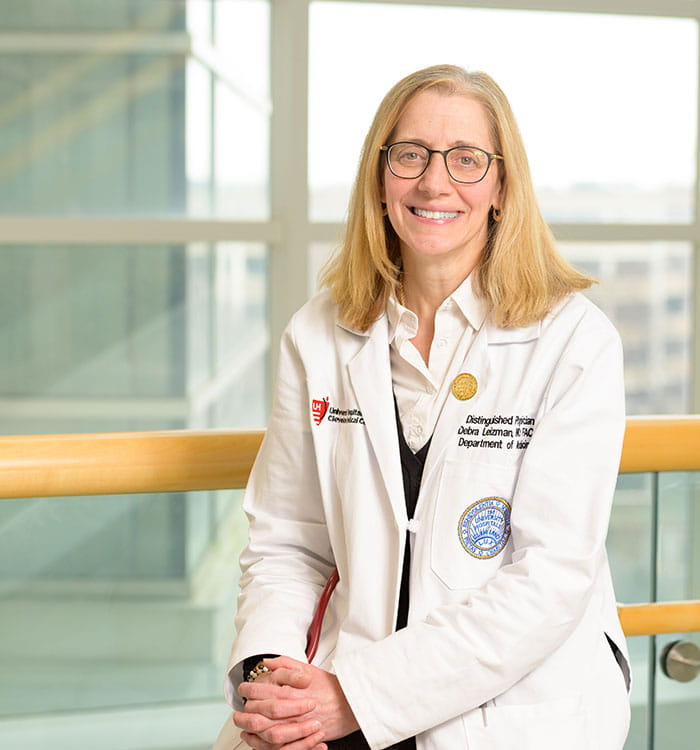Creative Solutions to Medical Education During a Pandemic
July 26, 2020
UH Research & Education Update | July 2020
 Debra Leizman, MD
Debra Leizman, MDWe all know how the coronavirus pandemic disrupted our daily lives. Still, it is humbling to learn how other individuals in our community were affected and responded to this disruption in their lives. On March 17, 2020, the Association of American Medical Schools (AAMC) announced, “The AAMC strongly supports medical schools pausing all student clinical rotations, effective immediately...” As a result, the education of the Case Western Reserve University medical students in clinical environments came to a halt. However, under the leadership of Debra Leizman’s MD, Internal Medicine, UH Cleveland Medical Center, and Associate Professor, Case Western Reserve University School of Medicine, third and fourth-year medical students gained an unprecedented learning experience by helping the UH community during the coronavirus pandemic's onset.
Students were prohibited from helping on the frontline due to the limited personal protective equipment and safety precautions. Consequently, Dr. Leizman and the students became creative and thoughtful about how to stay engaged and to learn during this historical time. In April, medical education resumed virtually. One group at UH continued to teach the students how to care for real patients using telehealth skills and interviewing isolated hospital inpatients via a telephone conversation. The students were developing their history-taking skills, enhancing their organizational and critical reasoning skills with real patients. Students were caring for patients from a distance. These unique training circumstances not only taught the students how to be creative with their education but also how to thoughtfully interact with patients. Serving as research adjuncts, the medical students provided scientific support to the inpatient hospital resident teams as well as participated in virtual conferences about patient management and scholarship.
Furthermore, Dr. Leizman, along with Jacqueline Wang and Lucy Li, third and fourth-year medical students, and Morgan Greene, a second-year physician’s assistant student, led a group of students to help with the UH Coronavirus hotline. With the students' help, the hotline wait time was reduced dramatically within hours of students arriving and answering the calls. There was no wait time by the end of the first day, which had more than 1000 calls.
The students set up a daily schedule providing 8 students per shift to help staff the hotline for the next 3 months straight. Dr. Leizman and the hotline student champions also developed a workshop that provided new hotline team members with a formal orientation about telephone medicine, COVID, and UH COVID guidelines to ensure everyone was delivering the same message. More than 100 students worked thousands of hours at the hotline command center.
Jacqueline and Lucy also created a daily coronavirus newsletter, which included links to the most current treatment guidelines, global research efforts and news, and a cautionary notes regarding false communications about COVID. The newsletter was so valuable, the team of students became an advisory task force to the UH COVID Command Center.
While some students chose to earn school credit for their work during the first three months of the pandemic, all of them were happy to participate and contribute to the community during this unprecedented time. The Case students ended their hotline participation on May 22 and resumed clinical training on June 1.
As the Director of Medical Student Education, Dr. Leizman oversaw the development and management of other unique medical student clinical electives which served the UH community during the pandemic and offered additional educational opportunities to the Case students without direct patient interaction. Jeffrey Luk, MD, and Philip Chang, MD, developed a Command Center Elective where students served as scribes for the UH command team. As students took notes, they were learning about emergency medicine, hospital administration, and disaster planning while gaining a rare insight into how a major academic medical center manages the day-to-day needs of an evolving real-life disaster. Students with a future career interest in emergency medicine in particular were enthusiastic to participate and these students helped to develop a format for the Command Center to use to manage and track the policies (i.e., testing locations, visitor policies, etc.) that were changing ever so quickly as the pandemic evolved.
Finally, other medical students who were frustrated they could not help provide patient care became creative and organized a support system for UH frontline workers. Many students helped frontline employees by babysitting, grocery shopping, walking dogs, and creating masks.
Dr. Leizman, her colleagues and the Case Western Reserve School of Medicine students brought to life the UH values of excellence, compassion and teamwork by creating a community of support and action when it was needed the most. UH providers cherish the opportunity to teach the Case medical students and value their involvement at UH. It was amazing how the students, recognizing their part in the UH community were able to give back seamlessly to the community around them. Their efforts and dedication demonstrate how the students have learned from the UH providers our core values of compassion to heal, learn and discover.
Tags: Medical Education, COVID-19


